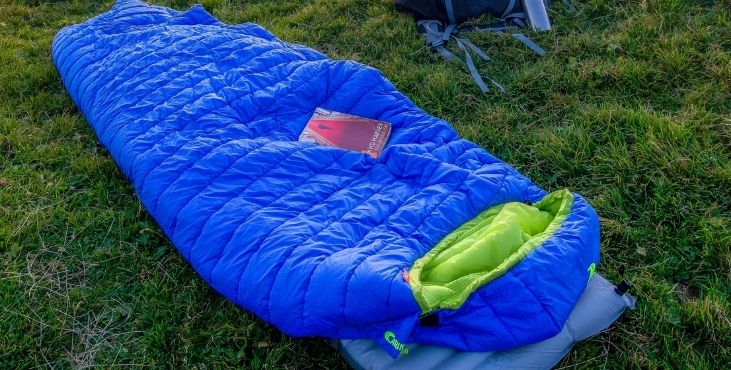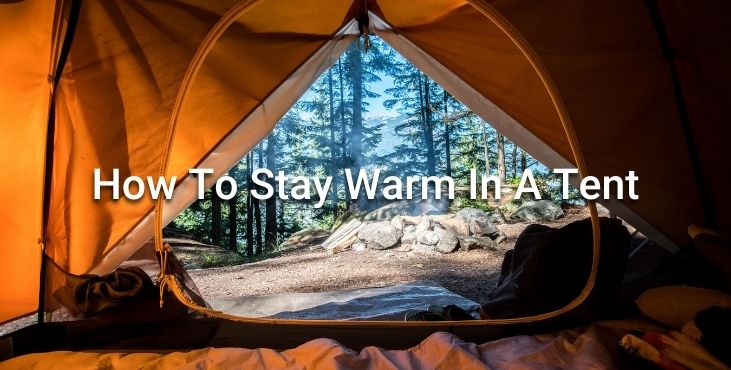As soon as the weather breaks and the first signs of Spring are in the air, us dedicated campers are packing our kit and getting out into the great outdoors. Nothing beats that first camping trip of the year, the fresh air, peace and quiet and satisfied feeling you get after a day’s hike, a good meal and a couple of hours around the fire. The problem is you lose the light early at the start of the season, and as the light fades, the temperature drops.
We’ve put this article together to help you prepare for the cold nights of early Spring. That old saying was never more apt than when applied to camping;
Fail to prepare, prepare to fail
So here’s our top tips on how to stay warm in a tent, starting with the most obvious, but also covering some ideas you might not have heard before.
Contents
- 1 Use A Suitable Tent
- 2 Use A Smaller Tent
- 3 Use A Tent Carpet
- 4 Get Into Your Bag Before You Get Cold
- 5 Wear Extra Layers
- 6 Use A Tent Heater
- 7 Use A Suitable Sleeping Bag
- 8 Get A Fleece Lined Sleeping Bag Liner
- 9 Use A Heat Reflective Blanket (Mylar)
- 10 Insulate Your Underlay
- 11 Wear Dry Socks To Bed
- 12 Leave The Air Mattress At Home
- 13 Remember To Dry Your Sleeping Bag Out
- 14 Vent The Tent
- 15 Sleep In A Hat
- 16 Dress Appropriately For Bed
- 17 Wear A Scarf To Bed
- 18 Pitch Your Tent In The Best Spot
- 19 Have A High Calorie Meal Before Bed
- 20 Cut Down Liquid Intake At Night
- 21 Hot Water Bottle
- 22 Invest In A Hurricane Lamp
- 23 Late Evening Exercises
- 24 Use Hot Rocks
- 25 Snuggle Up
- 26 Use Hand Warmers
Use A Suitable Tent
Tents come with different season ratings. Choose the correct rating for the weather conditions you are expecting to experience. A 4-season tent is for extremely cold Winter conditions and a 3-season tent is suitable for the other 3 seasons, with a one season tent only to be used in Summer.
Use A Smaller Tent
When we are in our tent we are the primary heat source in that tent. So it stands to reason that the smaller the area we need to heat up, the warmer that area will be.
Use A Tent Carpet
A tent carpet goes on top of the groundsheet and provides another layer between you and the cold ground. If you don’t have a tent carpet, a car rug or similar will work almost as well.
Get Into Your Bag Before You Get Cold
It’s always easier to stay warm than it is to get warm. Don’t allow your core temperature to drop as it will take forever to regain that heat.
Wear Extra Layers
As soon as the temperature drops in the early evening, put on another fleece or anything that will prevent your core temperature from dropping.
Use A Tent Heater
These are specifically designed for use in tents and comply with all the relevant safety guidelines. We don’t suggest using it all night long, just turn it on to take the cold edge off the tent a while before you turn in for the night.
Use A Suitable Sleeping Bag

For those early camping trips you need a decent sleeping bag that has the correct rating to keep you warm and cosy. The best rating for a comfortable night’s sleep under canvas is a zero rated sleeping bag. They can be purchased at all good outdoors stores and are readily available online and they’re not very expensive either.
Get A Fleece Lined Sleeping Bag Liner
Using a fleece lined sleeping bag liner will increase the rating of your sleeping bag by around 10 degrees.
Use A Heat Reflective Blanket (Mylar)
Commonly called space blankets, these mylar blankets are usually sold as emergency blankets. They work by reflecting the heat back onto you. Either place one on your sleeping mat, or cover yourself with it after you’re in your sleeping bag. Or even tape a mylar blanket to the ceiling of your tent and it will reflect any heat back at you in much the same way as you use aluminium foil when cooking food.
Insulate Your Underlay
We all use a sleeping pad because they work well, but in cold conditions lay a foam exercise mat under your sleeping pad. This saves losing heat through the floor of the tent and making your back cold.
Wear Dry Socks To Bed
It’s a given when it’s cold that you’ll sleep wearing your socks in your sleeping bag. But if those socks are damp they’ll add to your heat loss. Anything that’s damp equates to being cold, especially at 2 am in March under canvas.
Leave The Air Mattress At Home
It’s only natural to want to be comfortable when you’re camping, but air mattresses actually make you colder. Why? Because the air mattress is subject to the current temperature. Which means as the temperature in the tent drops, so does the temperature of the air in the mattress. So you get blasted from above and below with cold air.
Remember To Dry Your Sleeping Bag Out
Any dampness equals coldness, so after you’ve had a warm night’s sleep in your zero rated sleeping bag, roll it up from the feet upwards to remove any moisture. If possible lay the bag out in the sun to dry out completely.
Vent The Tent
This one sounds counter-productive and a little strange but we promise it works. If your tent is not adequately ventilated at night, heat from your body and breath can cause condensation to build up in the tent and make everything damp. As we keep pointing out –
Dampness = Coldness
If you ventilate the tent at night, you’ll cut down on condensation which means less moisture and therefore a warmer tent.
Sleep In A Hat
We’ve all seen those Victorian dramas where they wear bed hats at night right? Well they were onto something. Not only do we lose an average of 10% of our body heat through our heads, but if you don’t have your head buried under the sleeping bag you can’t create moisture inside the bag, and we all know what moisture causes.
Dress Appropriately For Bed
It’s not just your head that needs the correct attire, to keep warm at night in a tent, you need to wear suitable clothing. Never wear your day clothes for bed while camping due to, you guessed it, dampness. The correct attire for bedtime in a tent if you want to stay warm is…
Loose fitting thermal cotton pyjamas. Thermal for obvious reasons, cotton because it allows your body to breath and loose fitting to allow proper blood flow.
Wear A Scarf To Bed
By wrapping a scarf around your neck and face you will keep warm and won’t get damp inside the sleeping bag.
Pitch Your Tent In The Best Spot
By using a little bit of preplanning and forethought, it’s possible to keep the worst of the cold out. Never camp in a low-lying exposed area because cold air sinks to the lowest point. By the same token, don’t camp on any exposed ridges as these will catch any wind that’s about. Make use of the natural cover like boulders, trees, hollows and anything else that can act as a natural windbreaker.
Have A High Calorie Meal Before Bed

From a purely scientific point of view, calories are units of heat. High calorie foods equal a warmer body (and a fat body too if you consume too many calories regularly) so when you’re camping it’s OK to have an extra burger. As the body digests food, it will help to warm you up.
Cut Down Liquid Intake At Night
It’s important to stay hydrated, but get your liquids during daylight hours and limit your fluid intake in the evening. That way you will need to get up less during the cold nights. If you really are desperate to urinate during the Wee hours (pun intended) use a pee bottle, we know, disgusting right? But it’s better than exposing yourself to the below freezing temperatures outside your sleeping bag and tent.
Hot Water Bottle
No we’re not saying use your pee bottle as a hot water bottle, although, it would work. Just warm some water and fill a bottle and place it in your sleeping bag about 30 minutes before you turn in. Make sure the top is secure, because if you get the inside of the sleeping bag wet… You know where we’re going with that right?
Invest In A Hurricane Lamp
Set up a hurricane lamp and hang it in the tent so that you can’t accidentally knock it over. As it is burning all through the night, it will take the cold edge off the interior of the tent.
Late Evening Exercises
Get your blood flowing by doing some aerobic activities before bed. Squat thrusts, jumping jacks and burpees will get your heart pumping that warm blood all round your body. Get warm but don’t get sweaty, remember what moisture equals. Once you’re in your sleeping bag, if you get cold try a few crunches to warm up.
Use Hot Rocks
When you’re cooking dinner on the open fire, place a few rocks in the fire. Just before bed time remove them carefully, and wrap them in a towel. Place them inside your tent or even inside your sleeping bag to use that latent heat.
Snuggle Up
If you’re sharing your first camping trip of the season with a loved one, zip your sleeping bags together and maximise your combined heat. Your partner or dog will both work equally as well for this one.
Use Hand Warmers
When the mercury really drops, use two disposable hand warmers, place one near the foot of your sleeping bag to keep your feet toastie, and hold the other one on your chest. Even if it moves from your chest in the night, it will still be in the bag and still keep you warm.

Leave a Reply